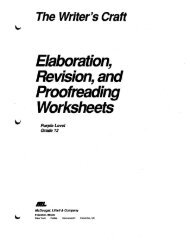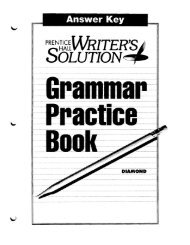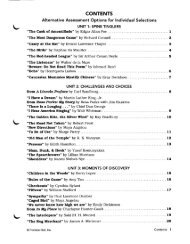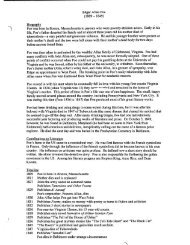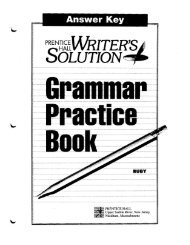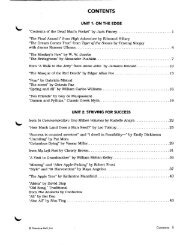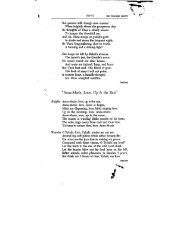Test - PopulationMe.com
Test - PopulationMe.com
Test - PopulationMe.com
- No tags were found...
You also want an ePaper? Increase the reach of your titles
YUMPU automatically turns print PDFs into web optimized ePapers that Google loves.
Background on the Novel Our word novel, meaning a long work ofprose fiction, <strong>com</strong>es from the French word for"new." The first true works of fiction as weknow it were the lengthy romances written inFrance and Spain during the sixteenth andseventeenth centuries. In fact, the Europeannovel is usually considered to have startedwith Don Quixote by Miguel de Cervantes(1605). In that novel, the contrast between aknight's impossible idealism and the practicalityof his squire introduces a key themedeveloped in later Western novels.The English used the old French word novelto describe these early French and Spanishstories and to differentiate them frommedieval and classical romances, indicatingthat they were something that was new anddifferent. A distinct literary form was born.Because of the increased levels of generaleducation and literacy in the eighteenth centUIy.the growth of fiction in general and ofthe novel in particular developed rapidly.Reading a novel even became a social event,and people read to one another as a means ofentertainment. In the first half of the eighteenthcentury. the works of Daniel Defoe.Samuel Richardson. and Henry Fieldinghelped to establish the novel in England.Their popularity contributed to the tremendousgrowth of fiction writing in the nineteenthcentury. Pamela; or Virtue Rewarded,by Samuel Richardson. published in 1740, isgenerally credited with being the first Englishnovel.For half a century after the publication ofPamela. no novels were written in the UnitedStates. The Power oj Sympathy. by WilliamHill Brown. published in 1789. was the firstnovel written by an American author andpublished in the United States. The first importantAmerican novelist. Charles BrockdenBrown. a Gothic writer. published four books atthe end of the eighteenth century.Many critics consider the novel's "greatestperiod" to be the mid- to late-nineteenthcentury. a period when increased literacyresulted in a wider potential readingaudience. Novelists of this period. and justbefore it. include the English writers CharlesDickens, William Makepeace Thackeray.Jane Austen. and George Eliot; the Frenchwriters Honore de Balzac. Gustave Flaubert,and Emile Zola, the leading exponent ofNaturalism; the Russian writers Ivan Turgenev.Leo Tolstoy. and Fyodor Dostoyevsk.y; and theAmerican writers Nathaniel Hawthorne.Herman Melville, and, later. Henry James. Withthis wider audience and greater demand. novelistscould earn a living with their words. Thenovel had arrived as a major genre ofliterature.The character of the novel changed in thetwentieth century as writers such as VirginiaWoolf. James Joyce. and Dorothy Richardsonwrote in the stream-of-consciousness style.and. in the process, extended the limits of theconventional and more realistic novel of thepreceding century. The use of the interiormonologue in stream-of-consciousness novels,best exemplified in James Joyce'sUlysses. employed language to re-create thenumerous impressions. in addition to rationalthought, that are part of the individual'sinterior consciousness. The early twentiethcentury produced a shift in the form andstructure ofthe novel. as writers probed moredeeply into the human mind; however, social,critical, and technical issues became the concernsof writers later in the twentieth century.Although twentieth-century writers soughtto stretch the limits of language, there arestill some constants that define the novel as agenre. First of all, it has a plot. or a centralconflict with which the characters struggle.Like most literature, novels have themes orideas about life that the story reveals. A novelistwrites from a point ofview that can be inthe first or third person. limited or omniscient.Certainly. tone and style are elementsof a novel as well. Most importantly. thenovel, no matter what its form, continues todeal with the essence of human experience inan imaginative and provocative way.© Prentice-Hall, Inc. 1



